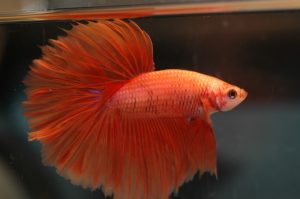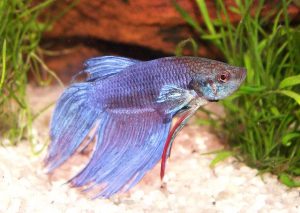
Imagine you’re a betta fish, swimming in your home, and suddenly you find yourself jostled around into a cramped 2-liter bottle for the rest of your brief life.
You’re not there because someone loves fish and want to take care of you, you’re just part of a child’s science experiment. Live animals are prohibited in the national science fair, but not in school classrooms. Texas middle schooler Ruby G. recently stepped up on behalf of the animals and may have saved thousands of (fish) lives over the next decades of classroom experiments.
Ruby’s 7th grade honors classroom was experimenting with different ecosystems with 2 liter soda bottles. A terrarium, with soil and bean or grass seeds is in a bottle on top. On the bottom was the aquarium bottle. A string between the 2 acts as a root system and carries water to the soil.

The aquarium ecosystem had gravel, aquatic plants called Duckweed, bottled spring water, and snails. The teacher also said they could add a betta fish and/or small fish. This is when Ruby started to realize putting fish in something that small was disastrous. It wasn’t just theory–fish in other classes had already died in the first week!
Her mother reports, “When we went to Petsmart to get aquatic plants for her team’s aquarium, the employee there said, ‘please don’t put any fish in those bottles.’ And she told Ruby that kids from her school had completely cleaned out the store buying betta fish. And she was asking her manager not to allow the kids to buy fish for that anymore.”
“So Ruby decided then and there she was going to do something about it. And when we came home from the store she got on the computer and started writing.”
A human being is a part of the whole called by us universe, a part limited in time and space. He experiences himself, his thoughts and feeling as something separated from the rest, a kind of optical delusion of his consciousness. This delusion is a kind of prison for us, restricting us to our personal desires and to affection for a few persons nearest to us. Our task must be to free ourselves from this prison by widening our circle of compassion to embrace all living creatures and the whole of nature in its beauty. – Einstein
Next, Ruby submitted her well-written paper to her teacher, who was convinced to stop using live fish in future science experiments in his classroom. While that might have disappointed a few of the children, most approved of the compassionate choice to not use animals in classroom experiments.
We all can make a difference in the world. We see injustices every day, to humans and other animals. We make choices with our actions and our words, our inactions and our silences. Brava to Ruby for standing up and getting things done!
Here’s Ruby’s paper:
The Act Against Fish and 2-liter Bottles
I would first like to state this- in the national science fair, live animals are prohibited. No animals are to be used- nor human subjects without permission slips. Now- I realize it’s not possible to ask a fish for a permission slip, but picture this. You’re taken out of your home/shelter and are put in a tiny containment space for a semester- about 18 weeks, with unusual amounts of food, and caretakers who know nothing about you. There you have it- exactly what happens to whatever fish, or shrimp you buy for your bottle project. It isn’t reasonable to leave these creatures with 12-13 year olds who just buy fish because they think it will look cool- they have no idea what the fish need- and as I’ve discovered, our teachers may not know anything about our water breathing friends either, seeing as if they did they would know the inch-per-gallon rule.
Betta Fish Living Conditions
Betta fish are actually a rare breed of fish called labyrinth fish. They need at least one gallon of water, though that is not recommended because it isn’t healthy. Typically, for every inch of fish (smaller fish), you need one gallon of water. Larger fish need 3. The Betta fish need five to thrive happily, a thermometer to keep track of water temperatures, and normal amounts of food. For the size of ‘tanks’ we keep them in, the water should be cleaned DAILY. The bottles used in our experiments are 2 liters- not even a gallon. With these conditions, this can be considered animal cruelty- in the case of not knowing the needs, and stable environment required to keep these creatures. Betta fish also should not be placed in direct sunlight, as it creates an unstable environment, causing an overgrowth of algae, also it may raise water temperatures over a normal 78-80 degrees. All bottles in my own classroom are left on the windowsills.
Shrimp Included in Bottle Projects
In normal aquariums, shrimp are food. For many fish besides Betta- but Betta fish are naturally aggressive and will not only eat, but kill the shrimp mere hours after placing it in the water with the fish. Shrimp are not meant to be put into 2-liter bottles with killer fish. They are food, when you want them to be. Emotional distress can impact children my age losing a shrimp, or fish.
Solution
If children wish to have fish in a science class, first, don’t put them in a bottle. Second, inform the children of the needs and expenses of a fish, including feeding habits, water temperature, and water purity. Third, make sure that they have an aquarium or plan for when the project is over so that a fish is not slowly being killed due to lack of attention, food, or water changes. Fish are intelligent, beautiful beings, and should never be considered for a project like this. It isn’t right, and no teacher is well enough informed to know that, or else we wouldn’t have children feeding their Betta gummy worms, and laying them on paper towels, while removing all original water. Who knows what else has been done over the years? I ask you with all good intent- please ban living creatures in science classes, for the safety of the students- and the specimen.
“Even small fish are fish.” -Czech Proverb